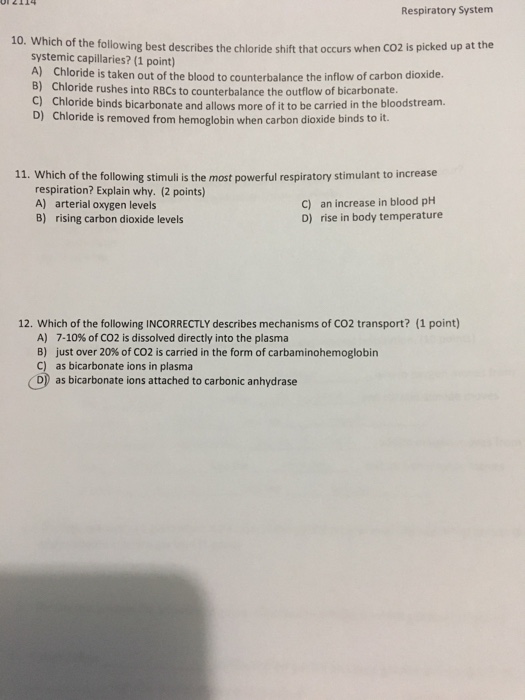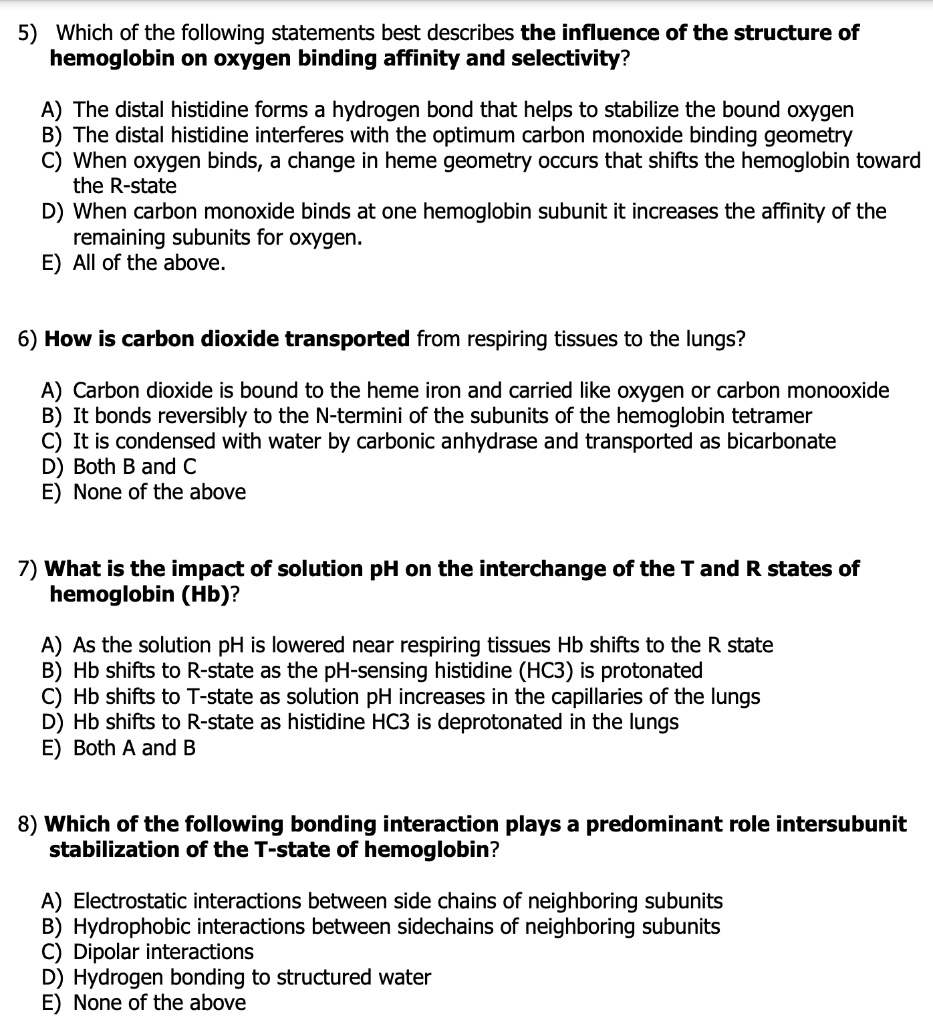Which Best Describes the Action of Carbonic Anhydrase
The enzyme carbonic anhydrase catalyzes the following reaction. This process also maintains blood pH by controlling the amount of bicarbonate ions and protons dissolved in the blood.

Solved Respiratory System 10 Which Of The Following Best Chegg Com
The correct answer is D Zn.

. 3It forms 600000 molecules of carbonic acid in one second. 2by catalyzing its conversion to the more soluble HCO. Which best describes the action of carbonic anhydrase.
It converts carbon dioxide and water to carbonic acid which dissociates into bicarbonate and hydrogen ions. This chapter describes the general mode of action of carbonic anhydrase in the context of CO 2 gasliquid scrubbing processes including descriptions of corresponding analytical and methods. With the buildup of carbonic acid concentrations in the red blood cells the carbonic acid dissociates into bicarbonate and H which results in the chloride shift.
2around the respiratory system is vital however the solubility of CO. Carbonic anhydrase enhances the solubility of CO. Carbonic anhydrase catalyzes the CO 2 hydration reaction and some lipid and.
It is primarily known for its role in transforming carbon dioxide to bicarbonate to be transported to the lungs. Which of the following is true about carbonic anhydrase. What Transport Process Is Responsible For Co2 Leaving Muscle Cells.
22 shows the role of carbonic anhydrase in the PCT of the kidney. Carbonic anhydrase has a molecular weight of 30000 gmol and a turnover number of. Carbonic anhydrases CAs EC 4211 catalyze the interconversion between CO2 and bicarbonate as well as other hydrolytic reactions.
The active site for most carbonic anhydrase is supposed to be a zinc ion and it is as a result classified as metalloenzymes. Function of Carbonic Anhydrase. The enzyme at a site away from the active site and inhibits the enzyme action.
The carbonic anhydrases form a family of enzymes that catalyze the interconversion between carbon dioxide and water and the dissociated ions of carbonic acid. Up to now at least eight isoenzymes have been found in mammals. Carbonic anhydrase catalyzes step 1 in a reversible manner.
Hence they are widely distributed and can be found in mammals plants and bacteria. ______ law states that the amount of gas dissolved in water is determined by its solubility in the fluid and the partial pressure of the gas in the surrounding air. Carbonic anhydrase converts carbon dioxide to bicarbonate primarily in red blood cells.
Step 2 the dissociation of carbonic acid into bicarbonate and a proton is a spontaneous phenomenon. They are therefore classified as metalloenzymes. This chemical reaction is essential for the life of prokaryotes and eukaryotes.
Seven genetic families of CAs have been discovered to date the α- β γ- δ- ζ- η- and θ-CAs which have been characterized by kinetic and X-ray crystallographic studies allowing a deep understanding of the structurefunction relationship. Which best describes the action of carbonic anhydrase. In summary the carbon dioxide produced by the cells is converted within the systemic capillaries mostly through the action of carbonic anhydrase in the red blood cells to carbonic acid.
The transport of CO. Other than helping in the transport of carbon dioxide the enzyme also maintains acid-base balance aids in the regulation of pH and helps maintain fluid balance. The cofactor of carbonic anhydrase is Zn2ions.
Inhibition of carbonic anhydrase at the proximal convoluted tubule b. Carbonic anhydrase CA is a zinc-containing metalloenzyme. 4All of these Biomolecules Zoology - Mini Question Bank NEET Practice Questions MCQs Past Year.
Thecarbonic anhydrasesCA form a family of enzymes that catalyze. Inhibition of the Na-Cl co- transporter at the thin ascending limb of the Loop of Henle d. Carbonic anhydrase is a catalyzed hydration of carbon dioxide into bicarbonate ions and protons.
This reaction is important in the transport of carbon dioxide by red blood cells. The enzyme maintains acid-base balance and helps transport carbon dioxide. Which option describes the most likely effect on the rate of reaction in each tube compared with the control.
2in water at physiological conditions is very small. Carbonic anhydrases convert carbon dioxide into carbonic acid H2CO3 H 2 CO 3 which is then hydrolyzed into bicarbonate HCO3 and hydrogen peroxide H. Carbonic anhydrase which is found within red blood cells catalyzes a reaction converting CO2 and water into carbonic acid which dissociates into protons and bicarbonate ions.
Inhibition of the Na-K-2Cl co- transporter at the thick ascending limb of the Loop of Henle c. C carbonic anhydrase catalyzes the conversion of CO2 and H20 into bicarbonate and hydrogen ions d bicarbonate ions HCO3 bind to hemoglobin and. The chloride shift allows RBCs to continue to produce carbonic acid.
Explore more such questions and answers at BYJUS. 1It accelerates the rate of formation of carbonic acid by 10 million times. Their structure distribution and properties are different and are related to the secretion of H- and bicarbonate from various epithelial cells.
The active site of most carbonic anhydrases contains a zinc ion. The current state of the art in carbonic anhydrase diversity and characteristics relevant to CO 2 scrubbing applications are reviewed. It converts carbon dioxide and water to carbonic acid which dissociates into bicarbonate and hydrogen ions.
Carbonic anhydrase is a protein that helps regulate the acid-base balance and pH in blood and other animal tissues. Inhibition of the Na-Cl co- transporter at the distal convoluted tubule e. 2In its absence only 200 molecules of carbonic acid is formed in an hour.

Solved When Tissues Of The Body Are Unloading Co2 Into The Chegg Com

Solved 5 Which Of The Following Statements Best Describes The Influence Of The Structure Of Hemoglobin On Oxygen Binding Affinity And Selectivity A The Distal Histidine Forms A Hydrogen Bond That Helps To

No comments for "Which Best Describes the Action of Carbonic Anhydrase"
Post a Comment